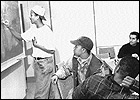![]()
![]()
![]()
![]()
![]()
![]()
Improving
Outreach
University Launches Initiative to Improve Administrative Structure, Get More Faculty and Staff Involved in Programs
Posted November 17, 1999
|
|
|
The challenge is how to integrate their different approaches so that together they provide the maximum benefit for schools, students and families.
"We need to work successfully," said Chancellor Berdahl, "to build collaborations that enhance the effectiveness of our programs at the same time that they respect the individual cultures and goals of each."
That's where a new effort, to research university and school partnerships here and across the nation, comes in.
By taking a look at the most successful models of academic outreach, the campus hopes to lay the groundwork for a more coordinated academic outreach program involving more faculty and staff.
"The current organizational structure, which is rather diffuse, isn't working as effective as it might," Executive Vice Chancellor and Provost Carol Christ said. "We have to ask ourselves what makes sense and how should we do this."
Research is being conducted by Gail Kaufman, chief of staff for Undergraduate Affairs, and Nina Robinson, manager of policy, planning and analysis for Admissions and Enrollment. Together with Eugene Garcia, dean of the Graduate School of Education, they will look for the best models to emulate.
The work is important, Kaufman said, in light of the university's desire to work closely with K-12 schools and to achieve more diversity.
"So many people are concerned about these issues, so you want to obviously make your investment -- not just monetary investment, but time and energy and commitment -- all work together," said Kaufman. "The question is how to be organized and create the synergy to make that happen."
Garcia, in his new role as adviser to the Chancellor on Berkeley Educational Partnerships, will use the research findings to help plan organizational changes. While continuing as dean, he will also serve as a campus spokesman for educational outreach and advise Berdahl and Christ.
An important aspect of his role as adviser to Christ and Berdahl will be developing a faculty center for academic outreach.
The center, which may not have a dedicated physical space, will bring together resources for faculty members to create outreach opportunities. It will help faculty members already involved in outreach do more, and encourage those not involved to take a role.
"I think we need to assess what exactly the faculty are doing and in what areas they may be able to do more," Garcia said, "and create a structure which allows that to happen."
Academic outreach is a long-standing tradition at Berkeley, said Garcia.
"We always want to bring the very best students to Berkeley," he said. "We want to be able to say to the students who are the best students in the K-12 segment that Berkeley is a viable option to them. We can't sit back and rest on our laurels and hope they apply here."
But outreach is not just about recruitment, Garcia said. Berkeley must build partnerships with community colleges, other universities and the K-12 schools to prepare students for higher education.
"We're coming to a new educational realization that we're all working together," he said.
Diversity is also key, Garcia said. Outreach allows the university to help underrepresented minorities prepare for UC admission, hopefully leading to a student body that closely mirrors the ethnically diverse population of California.
The team hopes to complete the research phase of its work by March. Changes based on its findings should be implemented in one to three years, according to Garcia.
RELATED STORY: A
Strategic Plan for Campus
Diversity
The research team welcomes examples of effective partnerships between universities, communities and schools. Kaufman may be reached at 643-9206, Robinson at 642-7117, Garcia at 643-6644.
![]()
![]()
November 17 - 23,
1999 (Volume 28, Number 15)
Copyright 1999, The Regents of the University of
California.
Produced and maintained by the Office
of Public Affairs
at UC
Berkeley.
Comments? E-mail berkeleyan@pa.urel.berkeley.edu.
